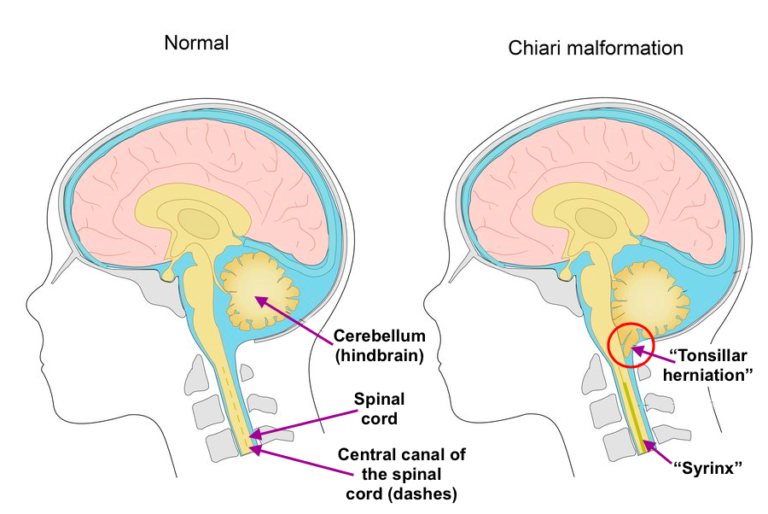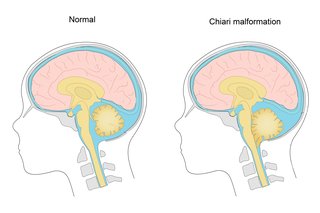Chiari malformations are usually caused by structural defects in the brain and spinal cord. Complications of Chiari type I malformation patients include an increased risk of concussion and post-concussion syndrome.
 Chiari Malformation Altair Health
Chiari Malformation Altair Health
Chiari I malformation is the most common variant of the Chiari malformations and is characterized by a caudal descent of the cerebellar tonsils and brainstem in its subtype Chiari 15 through the foramen magnum.

Chiari malformation type 1. Type 1which may not cause symptomsis the most common form of CM. Chiari Malformation type I CM-I is a neurological disorder characterized by a displacement of the cerebellar tonsils through the foramen magnum into the spinal canal. In Chiari malformation type I signs and symptoms usually appear during late childhood or adulthood.
Type 1 Type 1 occurs when the lower part of the cerebellum extends into the spinal canal. This hole is called the foramen fer-AY-men magnum. In someone with Chiari I the lowest part of the back of the brain extends into the spinal canal.
CMs can cause headaches difficulty swallowing vomiting dizziness neck pain unsteady gait poor hand coordination numbness and tingling of the hands and feet and speech problems. In this disorder the portion of the brain called the cerebellum andor brainstem lies lower than usual. Normally only the spinal cord passes through this opening.
It can cause the accumulation of excess fluid within your brain which may require placement of a flexible tube to. A Chiari malformation CM is a problem with how the brain sits in the skull. MRI is the imaging modality of choice.
A Chiari malformation previously called an Arnold-Chiari malformation is where the lower part of the brain pushes down into the spinal canal. Due to genetic mutations or a maternal diet that lacked. Type 1 Chiari malformations CM-1 are usually defined by displacement of only the cerebellar tonsils at least 5 mm below the level of the foramen magnum.
That means that your condition is not a consequence of trauma or infection but rather something that came about as your body was growing. There are 4 types of Chiari malformation depending on the part of the brain that is pushed down into the spinal canal. Less often people may experience ringing or buzzing in the ears weakness slow heart rhythm or fast heart rhythm curvature of the.
Chiari malformation is a structural defect in the cerebellum characterized by a downward displacement of one or both cerebellar tonsils through the foramen magnum. As you grow your brain and skull get larger together. Type 1 Chiari malformations are typically developmental in nature.
About Chiari Malformation Type 1. This can happen because of an injury contact with harmful substances or an infection. Most research has focused on physical symptomatology but few studies include neuropsychological examinations.
The brain normally sits fully inside the skull. They generally occur after sudden coughing sneezing or straining. The malformation occurs when the lower part of the cerebellum extends below the foramen magnum the large hole at the base of the skull which allows passage of the spinal cord without involving the brainstem.
Type 2 Chiari malformations CM-2 occur when not only the tonsils but also part of the cerebellar vermis breaches the foramen magnum. What is a Chiari malformation. Headaches often severe are the classic symptom of Chiari malformation.
Chiari malformation type 1 can sometimes lead to serious health complications. Moreover although cu. A Chiari malformation CM is a condition that affects the position of your brain within your skull.
There are 4 main types but type 1 called Chiari I is the most common. People with Chiari malformation type I can also experience. Chiari type 1 malformation CM1 occurs in the region where the brain and the spinal cord join.
Chiari malformation Type I Type 1 happens when the lower part of the cerebellum called the cerebellar tonsils extends into the foramen magnum. Chiari malformation type I. It is caused by excess leaking of spinal fluid from the lower back lumbar or chest thoracic areas of the spine.
In some cases more brain tissue also dips down through this opening. In other patients Chiari malformation can be progressive and lead to other complications such as. Chiari malformation type 1 is a structural abnormality of the cerebellum the part of the brain that controls balance and the skull.
It is the most common type. This blocks the normal flow of cerebral spinal fluid CSF between the brain and spinal canal. Your cerebellum lower part of the brain is pushed through the hole at the bottom of your skull.
Chiari I malformation key-AR-ee mal-fore-MAY-shun is when the cerebellum the part of the brain that controls coordination and muscle movement pushes down through the hole in the bottom of the skull. These defects develop during fetal development. An acquired Chiari malformation type I happens to a person after birth.
En espanol Malformacion de Chiari tipo I What Is Chiari I Malformation. With a Chiari malformation the lower part of the brain cerebellum dips down through a normal opening foramen magnum at the bottom of the skull. Symptoms are proportional to the degree of descent.
Spina bifida incomplete closing of the spine and spinal cord covering.
 Arnold Chiari Type I Malformation C N S Neurosurgery
Arnold Chiari Type I Malformation C N S Neurosurgery
 Chiari Malformation Symptoms And Causes Mayo Clinic
Chiari Malformation Symptoms And Causes Mayo Clinic
 Chiari I Malformation For Parents Nemours Kidshealth
Chiari I Malformation For Parents Nemours Kidshealth
 Chiari Malformation Symptoms Causes And More
Chiari Malformation Symptoms Causes And More
 Arnold Chiari Malformation Symptoms Types And Treatment
Arnold Chiari Malformation Symptoms Types And Treatment
 Chiari Type 1 Deformity Operative Neurosurgery
Chiari Type 1 Deformity Operative Neurosurgery
 Anesthetic Management Of Parturients With Arnold Chiari Malformation I A Multicenter Retrospective Study International Journal Of Obstetric Anesthesia
Anesthetic Management Of Parturients With Arnold Chiari Malformation I A Multicenter Retrospective Study International Journal Of Obstetric Anesthesia
 Arnold Chiari Malformation Type 1 By Isabella Avery
Arnold Chiari Malformation Type 1 By Isabella Avery
 Frequently Asked Questions Chiari Malformation Faqs Ucla Health Pediatric Neurosurgery Los Angeles Ca
Frequently Asked Questions Chiari Malformation Faqs Ucla Health Pediatric Neurosurgery Los Angeles Ca
 Frequently Asked Questions Chiari Malformation Faqs Ucla Health Pediatric Neurosurgery Los Angeles Ca
Frequently Asked Questions Chiari Malformation Faqs Ucla Health Pediatric Neurosurgery Los Angeles Ca
 Chiari Malformation Type 1 Chiari Malformation Chiari Radiculopathy
Chiari Malformation Type 1 Chiari Malformation Chiari Radiculopathy


